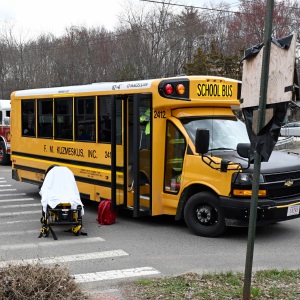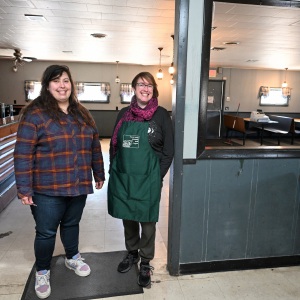Local stores report a drop in those using HIP benefits since cuts took place
| Published: 01-10-2025 5:27 PM |
Just over a month since Healthy Incentives Program (HIP) benefits were cut by a minimum of 50%, local businesses and advocates for the initiative are hopeful that it will be restored, as farmers, vendors and stores are seeing the effects of reduced benefits.
HIP is a program that puts money back on EBT cards when folks use their Supplemental Nutrition Assistance Program (SNAP) benefits to buy healthy, local produce from HIP vendors. Both HIP and SNAP are administered by the Department of Transitional Assistance.
In December, HIP benefits, regardless of household size, were reduced to $20. The DTA made the reductions to ensure the program can operate through the end of the fiscal year at its current level of funding. The previous benefit model saw households of one to two people receiving up to $40, households of three to five people getting up to $60 and houses of six or more people getting up to $80 per month.
The effects of those cuts are becoming apparent at stores around the region, such as at Atlas Farm Store, where owner and manager Kelly Hickey said December HIP and SNAP sales — the state combines the numbers — were down 27% from the previous year, a stark decrease compared to the average 15% to 20% increase the store typically sees every year.
“People are still coming out, but we’re not seeing as many people. We’re not seeing people get everything they want. … Their budget is so much tighter,” Hickey said, adding that the last day of November saw its highest-ever percentage of SNAP/HIP sales. Dec. 1, she noted, was the lowest percentage of those sales the store ever had.
In November, the month prior to the reduction, 43,039 households across Massachusetts participated in HIP, totaling 72,027 transactions with an average incentive of $39.46 per household, according to data released by DTA. Data is not available for December 2024 yet.
At Quabbin Harvest Food Co-op in Orange, interim Team Leader Camille Bedaw said the decrease in HIP shoppers has been evident since the reductions took place.
“We’ve definitely had a decrease in people who are utilizing the HIP program,” Bedaw said. “Those people aren’t coming in and shopping like they used too. … Not having those people come in hurts.”
Article continues after...
Yesterday's Most Read Articles
 Vehicle collides with school bus causing minor injuries in Montague City
Vehicle collides with school bus causing minor injuries in Montague City
 UMass faculty calls on land grant universities to join in fight against Trump administration; McGovern, AG also weigh in
UMass faculty calls on land grant universities to join in fight against Trump administration; McGovern, AG also weigh in
 Franklin County Technical School Committee votes to oppose lottery system
Franklin County Technical School Committee votes to oppose lottery system
 Franklin County, North Quabbin groups send letter opposing pipeline expansion
Franklin County, North Quabbin groups send letter opposing pipeline expansion
 HS Roundup: Smith Academy baseball knocks off Mahar, 5-1
HS Roundup: Smith Academy baseball knocks off Mahar, 5-1
 Termination of $300K federal grant presents ‘an institutional setback’ for PVMA
Termination of $300K federal grant presents ‘an institutional setback’ for PVMA
While it hurts financially, Hickey said it also takes a personal toll on everyone involved, starting with the farmers and vendors.
“It’s the feeling of helping people put back an apple [when they can’t afford it],” she said. “We’re really feeling for our vendors and customers.”
Those more widespread concerns are also shared by South Deerfield-based Community Involved in Sustaining Agriculture (CISA), as interim Executive Director Kelly Coleman said the cuts are having “immediate negative impacts on families who rely on HIP and on winter sales for vendors.”
“We’re also hearing from farmers that this reduction introduces a whole new level of uncertainty as they plan for the coming growing season, especially those that offer CSA shares or sell products year-round,” Coleman said. “We are continuing to advocate that the governor and legislative leadership pass a supplemental budget to restore full funding for HIP for the rest of the fiscal year.”
Bedaw said she and her team are hopeful the state can restore the funding.
“From what we’ve heard, they’re working really hard on getting it restored,” she said. “It’s a great program and it helps a lot of families in the area.”
HIP is funded through the state budget process and Gov. Maura Healey’s initial fiscal year 2025 proposal requested $25 million for HIP. The final budget, though, provided only $15 million.
State finance laws require DTA to operate within the appropriated budget for the agency.
To restore the program back to its previous levels, the $10 million shortfall would need to be filled by a supplemental budget, which needs to be filed by Healey, according to state Sen. Jo Comerford, D-Northampton.
Attempts to reach the governor’s office were unsuccessful. Healey filed a supplemental budget request on Jan. 6 for $425 million to fund the state’s Emergency Assistance (EA) shelter program.
Comerford said the Legislature anticipates another supplemental budget soon and once it is filed, she expects the House and Senate to act quickly on it.
“I recognize the delays are concerning. We need the governor to act, and I understand the supplemental [budget] is on her plate and that she’s working on it,” Comerford said. “I can tell you the leadership in the Senate is completely tuned in on the Healthy Incentives Program. … This is a legislative priority program, it makes it even more imperative that the Legislature act.”
She said the ongoing push to restore HIP has been “one of the major advocacy campaigns we’ve seen in the last handful of weeks.” Coleman added that CISA has participated in a wide-ranging coalition of advocates to prevent the cuts and, now, restore the funding.
“CISA, along with many partner organizations, HIP vendor farms and markets, community members and supportive legislators, did a lot of advocacy work in the hopes that we could stave off the HIP cuts,” Coleman said. “Unfortunately, the state did not increase this program’s funding, and now we’re over a month into the benefit reduction.”
Comerford noted the HIP program is a “triple win” as it spurs economic development, puts healthy food into people’s hands and boosts revenue for farmers.
“For example, a farmers market, that farmers market will attract more people because they have more money to spend and they might choose to buy something that is not covered by SNAP or HIP,” Comerford said. “It’s a positive reinforcing program.”
In the meantime, SNAP benefits remain an option for folks and there may be opportunities for people to maximize their SNAP benefits by reporting expenses, such as housing or medical costs, to the DTA. More information can be found at bit.ly/40iouca.
If people need help finding food, they can locate the nearest pantry or meal program through the Western Massachusetts Food Assistance Network at the Food Bank of Western Massachusetts’ website at bit.ly/40tQDhI.
Chris Larabee can be reached at clarabee@recorder.com.








 ‘Courage, not acquiescence’: McGovern encourages increased engagement during Trump administration
‘Courage, not acquiescence’: McGovern encourages increased engagement during Trump administration AG pledges to help fight opioid crisis in visit to Greenfield
AG pledges to help fight opioid crisis in visit to Greenfield Larger location for Orange Food Pantry comes in wake of increased participation, hopes for new programs
Larger location for Orange Food Pantry comes in wake of increased participation, hopes for new programs
